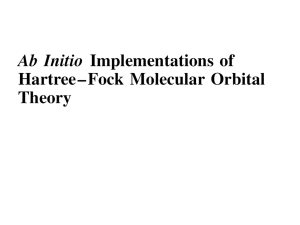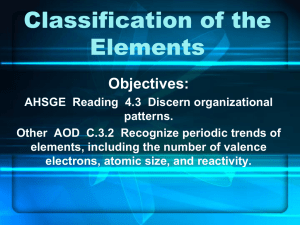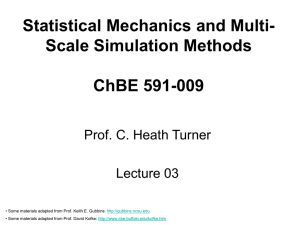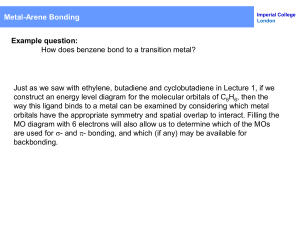The Structure and Spectroscopy of Hydrogen
advertisement
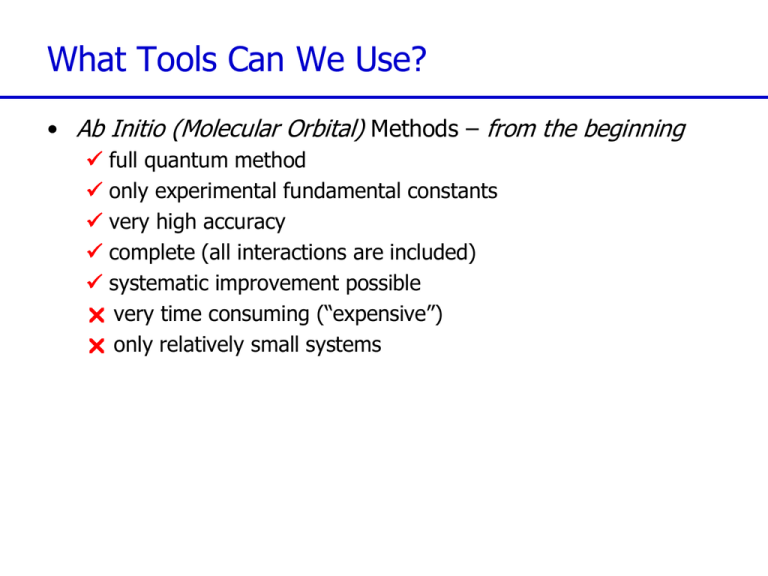
What Tools Can We Use? • Ab Initio (Molecular Orbital) Methods – from the beginning full quantum method only experimental fundamental constants very high accuracy complete (all interactions are included) systematic improvement possible very time consuming (“expensive”) only relatively small systems What is Molecular Orbital Theory? Molecular orbitals of the hydrogen molecule - constructed from hydrogen 1s atomic orbitals (basis functions) s*~ (1sA - 1sB) 1sA 0.735 Å (H2) s ~ (1sA + 1sB) 1sB Ab Initio Methods Key Steps Schrödinger Equation H E Space & Time separation ( r ,t ) ( r )( t) H( r ) E( r ) Non Relativistic Hamiltonian Separate motion of electrons and nuclei 2 2 H TV V 2 Born-Oppenheimer Approximation Normalisation ( r ,R ) ( r )( R ) 2 c d 1 Antisymmetrisation (Slater Determinants) ( r1 ,... ri ,r j ,... rn ) ( r1 ,... r j ,ri ,... rn ) Molecular Orbitals ( r ) 1 ( r1 ) 2 ( r2 )... v ( rv ) Ab Initio Methods Key Steps Molecular Orbitals LCAO ( r ) 1 ( r1 ) 2 ( r2 )... v ( rv ) N i c i 1 Basis Functions Variation Principle n m l 2 g( ,r ) Cx y z exp( r ) E ( i ) E ( ) For any antisymmetric, normalized wavefunction, the expectation value for the energy will always be greater than the energy of the exact wavefunction. Assumptions • Non-Relativistic – relativistic effects scale naively as Z4/c2 where c = 137 • Born-Oppenheimer approximation – If nuclear motion is treated as a perturbation, the appropriate parameter is M–1/4, even for H nuclear motion the effects are expected to be small. However, there are circumstances where the Born-Oppenheimer approximation breaks down: crossing electronic states, very high rotational excitation… • Finite nuclear size – ignore Assumptions Practical Approximations: • The Hamiltonian • The wavefunction is expanded in terms of one-electron functions, the one-particle space is truncated • The N-particle basis is not complete, the N-particle space is truncated Ab Initio Methods • Heirarchy of methods to treat electron-electron interactions electron correlation ie what approximation do we use for H? - repulsion attraction + attraction • Hartree-Fock theory – just consider 1 electron + “average” repulsion – Need an initial guess of the average repulsion (ie the electron density) – Iterate until self-consistent Accuracy of HF theory • Bond lengths and angles of “normal” organic molecules quite accurate (within 2%) • Conformational energies accurate to 1-2 kcal/mol • Vibrational frequencies for most covalent bonds systematically too high by 10-12% • Zero-point vibrational energies ~1-2 kcal/mol (usually scale by 0.9) • Protonation/Deprotonation energies ~10kcal/mol (gas phase) • Reaction barriers may (!!) have very large errors • Isodesmic reaction energies accurate to 2-5 kcal/mol (where number of bonds of each type are formally conserved) Limitations of HF theory Restricted Hartree-Fock Theory (RHF) – for an even number of electrons requires double occupancy of each molecular orbital – for an odd number of electrons requires that a single (say) spin up electron is added in an open shell orbital Consider the dissociation of the H2 molecule: H+ + H– H–H H + H In RHF H2 can only dissociate to a H+ and H– giving a “dissociation catastrophe” because we must have doubly occupied orbitals ie a doubly occupied orbital on H– and no electron on the H+! Limitations of HF theory Unrestricted Hartree-Fock Theory (UHF) – allows molecular orbitals to be singly occupied – allows the spin up molecular orbitals to be different in energy (and nature) to the spin down molecular orbitals. Consider the dissociation of the H2 molecule: H+ + H– H–H H + H In UHF H2 can dissociate to H + H but at the cost of different energy spin up and spin down orbitals (what does that mean?) and the loss of a pure spin states, ie UHF gives an incorrect spin function which is contaminated by spin states of higher multiplicity! Basis Sets • A standard way to solve a differential equation (like the Schrödinger equation) is to expand the solution in terms of a set of orthogonal basis functions • If you choose sensible functions, you might not need too many… • We have a wonderful set of sensible orthogonal functions to choose: atomic basis functions • Molecular orbitals really do look pretty much like the sum of the atomic orbitals on the atoms making up the molecule Atomic Orbitals • We only really have one-electron orbitals from the H atom, Slater functions: STO (r) e r • But no closed form for integration… Gaussian functions GTO (r) e r 2 • We can integrate these! STO N GTO k n n n1 Atomic Orbitals • We can fit multiple Gaussians to Slater functions when we have to integrate them: Minimal Basis Sets • Smallest possible number of atomic orbitals: – one basis orbital per two inner shell electrons – one basis orbital for each valence atomic orbital – For first-row elements there are basis functions resembling 1s, 2s, 2px, 2py, 2pz atomic orbitals. – The STO's are replaced by n GTO's for the purposes of evaluating necessary integrals (STO-nG basis set) These basis set should not be used for any serious calculation! Minimal (or Single Zeta) basis sets do not work well because they are not flexible enough to describe how the atomic orbitals deform in the molecule. Scaling Basis Sets • Typically atomic orbitals contract a little in a molecular environment, we need to model how they get smaller – We could make the exponent ζ bigger – But this leads to nasty non-linear optimisation problems… – We could let the atomic orbital get smaller by linearly combining it with a smaller orbital (ie with bigger ζ) – We now have twice as many orbitals but our optimisation is much easier Scaling Basis Sets N-Zeta Basis Sets • Double-Zeta Basis Sets – two Slater-type functions for each atomic orbital of the minimal basis (requiring two exponents, zeta - ), one which is closer to the nucleus, the other allowing for electron density to move away from the nucleus • Triple-Zeta Basis Sets – three Slater-type functions for each atomic orbital of the minimal basis (requiring three exponents, zeta – ) • Fit Gaussians to these for the relevant integrals Split Valence N-Zeta Basis Sets • Leave the core orbitals as a single Slater function • Add extra Slater functions only to the valence orbitals – Valence double-zeta – Valence triple-zeta – Valence quadruple-zeta • Fit Gaussians to these for the relevant integrals, take most care over the tightest Slater functions, ie the ones closest to the nucleus Split Valence N-Zeta Basis Sets • Valence double-zeta: – 3 Gaussians per core orbital – 2 Gaussians per “tight” valence orbital – 1 Gaussian per “normal” valence orbital – 6 Gaussians per core orbital – 3 Gaussians per “tight” valence orbital – 1 Gaussian per “normal” valence orbital Pople 3-21G Basis Pople 6-31G Basis • Valence triple-zeta: – – – – 6 3 1 1 Gaussians per core orbital Gaussians per “tight” valence orbital Gaussian per “sl smaller” valence orbital Gaussian per “sl bigger” valence orbital Pople 6-311G Basis Split Valence N-Zeta Basis Sets • Valence double-zeta: – 3 Gaussians per core orbital – 2 Gaussians per “tight” valence orbital – 1 Gaussian per “normal” valence orbital – 6 Gaussians per core orbital – 3 Gaussians per “tight” valence orbital – 1 Gaussian per “normal” valence orbital Pople 3-21G Basis Pople 6-31G Basis • Valence triple-zeta: – – – – 6 3 1 1 Gaussians per core orbital Gaussians per “tight” valence orbital Gaussian per “sl smaller” valence orbital Gaussian per “sl bigger” valence orbital Pople 6-311G Basis Extended Basis Sets • Orbitals change shape when you make a molecule • How do you make then “wigglier” • You add “polarisation” functions • The next shell up atomic orbitals do exactly what you want! Polarised Basis Sets • Add polarisation functions only to non-hydrogen atoms – H atoms are pretty spherical • Add one set of extra functions: – 6-31G(d)/6-31G* – 6-311G(d)/6-311G* • Add two sets of polarisation functions – 6-31G(2df) – 6-311G(2df) • Fit each extra polarisation function with a single gaussian if we have to integrate it Polarised Basis Sets • Add polarisation functions only to all atoms • Add one set of extra functions: – 6-31G(d,p)/6-31G** Dunning cc-pVDZ Basis – 6-311G(d,p)/6-311G** Dunning cc-pVTZ Basis • Add two sets of polarisation functions – 6-31G(2df,2pd) – 6-311G(2df,2pd) Dunning cc-2pVTZ • Fit each extra polarisation function with a single gaussian if we have to integrate it Polarised Basis Sets • Add polarisation functions only to all atoms • Add one set of extra functions: – 6-31G(d,p)/6-31G** Dunning cc-pVDZ Basis – 6-311G(d,p)/6-311G** Dunning cc-pVTZ Basis • Add two sets of polarisation functions – 6-31G(2df,2pd) – 6-311G(2df,2pd) Dunning cc-2pVTZ • Fit each extra polarisation function with a single gaussian if we have to integrate it In general, polarization functions significantly improve the description of molecular geometries (bond lengths and angles) as well as relative energies. Diffuse Basis Sets • In some molecules and ions the orbitals expand rather than contract – Anions – Regions of localised negative charge – Rydberg states… • Add one set of extra very diffuse (ie very small ) functions (per shell) model these with a single Gaussian as required – Add diffuse functions to non-H atoms (H is rarely –ve) – 6-31+G(d,p)/6-31+G** Dunning aug’-cc-pVDZ Basis – 6-311+G(d,p)/6-311+G** Dunning aug’-cc-pVTZ Basis • Add two sets of diffuse functions – 6-31++G(d,p) – 6-311++G(2df,2pd) Dunning aug’-cc-2pVTZ Basis Diffuse Basis Sets • You must use diffuse functions for – – – – anions zwitterions Rydberg states weakly bound species (hydrogen bonds, van der Waals complexes…) Commonly Used Basis Sets Basis Set Description No. of Basis Functions H C,O H2 O C6 H 6 STO-3G Minimal Basis Set. Cheap but not reliable 1 5 7 36 3-21G Double-split-valence (or double-zeta-valence). A small not always reliable basis set. 2 9 13 66 Split-valence + polarization basis. A popular mediumsized basis set 2 15 19 102 Another split-valence + polarization basis with p functions on H atoms 5 15 25 120 6-31G(d) 6-31G(d,p) Basis Sets for Heavy Atoms • Heavy atoms can be problematic – They have lots of electrons ignore most of them and replace them with an “effective core potential” instead – They have a large +ve nuclear charge so the core electrons experience huge forces and can travel at relativistic velocities use “relativistic core potentials” to empirically correct for relativistic effects – The energy spacing between the valence and the “core” electrons gets smaller use “small core” effective core potentials, or specially designed “core-valence” basis sets Basis Set Libraries https://bse.pnl.gov/bse/portal The Complete Basis Set (CBS) Limit • The electronic energy obtained with an infinitely large basis set • Basis set convergence is depressingly slow • One-electron basis functions cannot describe the singularities in the Coulomb potential (or wavefunction) as two electrons approach each other Wavefunction Cusp as two electrons approach R12; electron-electron distance Basis Set Take Home Messages • • • • • • Convergence is slow! Need polarization functions (d set on C, N, O.. p set on H…) For structures and frequencies at least a DZP basis is required to get close to the HF limit When mixing different basis sets, ie using different basis sets for different atoms (eg to model a transition metal complex you may need a specific transition metal basis and a basis for second row atoms) it is important to make sure each basis is of the same “quality”, ie do not mix, say, a DZ basis with a VTZ basis. A basis set must be physically big enough to span the interactions you are interested in! When choosing a basis set, choose the best basis set for your time and memory limits.
